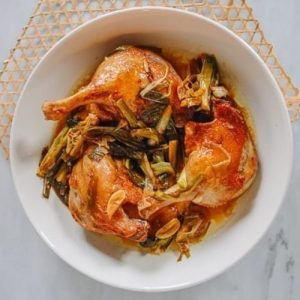
Chinese Braised Duck Legs Stew
Succulent duck legs braised in a savory sauce of soy, Shaoxing wine, and aromatics. Perfect over steamed rice, this high-protein, low-carb dish is easy to prepare, packed with flavor, and ideal for everyday meals or make-ahead dinners.
Equipment
- 1 deep skillet or Dutch oven
- 1 paper towel
- 1 fat separator (optional)
- Measuring cups and spoons
Ingredients
- 4 duck legs
- ¼ cup Shaoxing wine or rice wine/cooking sherry
- 2 cups low-sodium chicken stock
- 2 tablespoons soy sauce
- 2 tablespoons oyster sauce
- ½ teaspoon sesame oil
- ¼ teaspoon white pepper
- 3 slices fresh ginger
- 3 cloves garlic sliced
- 10 –12 scallions cut into 2-inch lengths
- 1 star anise optional
- 1 bay leaf optional
Instructions
- Prepare the Duck Legs: Start by rinsing each duck leg under cold running water. This removes any surface impurities and helps the meat stay clean. Trim off any excess fat—reserve this fat in a clean container if you’d like to use it later for roasting or frying, as it adds rich flavor. Pat each leg thoroughly with paper towels to remove all moisture; this ensures a crisp, golden sear in the next step.
- Preheat Your Oven and Skillet: Set your oven to 400°F (200°C) so it’s ready for braising later. Meanwhile, place a deep skillet or Dutch oven over medium-high heat. Allow it to heat fully; a properly preheated pan is essential for achieving that perfect, even browning on the duck skin.
- Sear the Duck Legs: Once the skillet is hot, gently place the duck legs in the pan with the skin side facing down. You should hear a gentle sizzle. Reduce the heat to medium-low and allow the skin to render and brown slowly. Resist the temptation to move the legs prematurely; letting them sit undisturbed ensures a uniform, crispy skin. Cook until the skin is evenly golden brown, about 6–8 minutes.
- Flip and Quickly Sear the Other Side: After the skin side is golden and fragrant, carefully flip each duck leg using tongs. Sear the meat side for just 1 minute—this helps lock in juices without overcooking. Once done, remove the duck legs from the skillet and set them aside on a plate.
- Remove and Reserve Excess Duck Fat: Pour off any excess rendered duck fat from the skillet, leaving just a thin layer for flavor. If you’ve reserved the fat, strain it through a fine sieve into a clean container and refrigerate. This fat can be used later in other dishes, giving them a rich, savory depth.
- Combine Aromatics and Braising Liquid: To the same skillet, add 1/4 cup Shaoxing wine, 2 cups low-sodium chicken stock, 2 tablespoons soy sauce, 2 tablespoons oyster sauce, 1/2 teaspoon sesame oil, and 1/4 teaspoon white pepper. Add sliced ginger, garlic, and 10–12 scallions cut into 2-inch lengths. If you’re using star anise and bay leaf, add them now. Stir gently to combine, scraping up any browned bits from the bottom of the pan—these caramelized bits add incredible flavor to the sauce.
- Return Duck Legs to the Skillet: Place the duck legs back into the skillet, skin side up. Make sure the liquid comes about halfway up the duck legs; the top part should remain above the liquid so the skin stays tender yet slightly crisp. This step ensures the meat braises evenly while absorbing the aromatic flavors.
- Simmer and Braise in the Oven: Bring the liquid to a gentle simmer on the stovetop. Once it starts simmering, carefully transfer the skillet to your preheated oven. Cook uncovered at 400°F (200°C) for 30 minutes. This initial high heat helps tenderize the duck while intensifying the flavors of the braising liquid.
- Lower the Oven Temperature: After 30 minutes, reduce the oven temperature to 350°F (175°C). Continue cooking uncovered for another 30–40 minutes, or until the duck legs are tender and the meat easily pulls away from the bone. During this stage, the flavors meld beautifully, creating a rich, aromatic sauce.
- Rest and Prepare for Serving: Once the duck is fully cooked, remove the skillet from the oven. Use a fat separator to pour off excess fat from the braising liquid, leaving a silky, flavorful sauce behind. Let the duck rest for 5 minutes before serving; this allows the juices to redistribute throughout the meat, keeping it moist and tender.
- Plate and Serve: Place the braised duck legs on a serving platter or individual plates. Pour some of the braising sauce over the duck. Serve immediately with steamed rice and sautéed greens, which soak up the flavorful sauce perfectly. Garnish with extra scallions if desired for a fresh, vibrant touch.
- Storage and Make-Ahead Tips: This dish can be prepared ahead of time. Keep it warm in the oven for up to an hour, or cool completely and refrigerate for up to 2 days. Reheat gently on the stovetop or in the oven, adding a splash of water or stock to maintain moisture.
Notes
- Duck fat can be rendered and stored for future use; it adds rich flavor to stir-fries, roasted vegetables, or fried rice.
- Searing the skin slowly over medium-low heat ensures crispiness without burning.
- Star anise and bay leaf are optional, but they add a subtle depth of flavor.
- Use low-sodium chicken stock to control saltiness; adjust soy sauce to taste.
- The recipe can be made ahead and gently reheated; flavors improve after resting.
- Scallions added at the end preserve freshness and a mild crunch.